
Terrorism and Drug Trafficking: Threats and Roles of Explosives and
Narcotics Detection Technology
(Briefing Report, 03/27/96,
GAO/NSIAD/RCED-96-76BR).
Pursuant to a congressional request, GAO provided information on drug
trafficking and terrorism in the United States, focusing on the
strategies and technologies developed to combat these threats.
GAO noted that: (1) the threat from terrorism within the United States
has increased and U.S. aviation is a prime target from terrorist groups
that are difficult to infiltrate; (2) drug trafficking continues to pose
a serious problem for the southwestern border, since most drug shipments
are smuggled by cars, trucks, and tractor-trailers; (3) the Federal
Aviation Administration (FAA) relies on a strategy of tailored response
to mandate security procedures commensurate with the level of threat at
specific times and places; (4) FAA mandates more stringent security
measures for international flights, including the use of x-ray screening
for checked baggage; (5) the Customs Service disseminates intelligence
on drug trafficking, targets high-threat conveyances and cargoes, and
uses detection technologies to detect drug-related activities; and (6)
FAA has certified an advanced automated explosive detection system for
75 of the busiest domestic airports, but has been unable to deploy it
because installation costs could reach as much as $2.2 billion.
--------------------------- Indexing Terms -----------------------------
REPORTNUM: NSIAD/RCED-96-76BR
TITLE: Terrorism and Drug Trafficking: Threats and Roles of
Explosives and Narcotics Detection Technology
DATE: 03/27/96
SUBJECT: Narcotics
Drug trafficking
Law enforcement
Terrorism
Commercial aviation
Explosives
Crime prevention
Intelligence gathering operations
Sabotage
Transportation safety
IDENTIFIER: Mexico
Colombia
Asia
NAFTA
North American Free Trade Agreement
******************************************************************
** This file contains an ASCII representation of the text of a **
** GAO report. Delineations within the text indicating chapter **
** titles, headings, and bullets are preserved. Major **
** divisions and subdivisions of the text, such as Chapters, **
** Sections, and Appendixes, are identified by double and **
** single lines. The numbers on the right end of these lines **
** indicate the position of each of the subsections in the **
** document outline. These numbers do NOT correspond with the **
** page numbers of the printed product. **
** **
** No attempt has been made to display graphic images, although **
** figure captions are reproduced. Tables are included, but **
** may not resemble those in the printed version. **
** **
** Please see the PDF (Portable Document Format) file, when **
** available, for a complete electronic file of the printed **
** document's contents. **
** **
** A printed copy of this report may be obtained from the GAO **
** Document Distribution Center. For further details, please **
** send an e-mail message to: **
** **
** <[email protected]> **
** **
** with the message 'info' in the body. **
******************************************************************
Cover
================================================================ COVER
Briefing Report to Congressional Requesters
March 1996
TERRORISM AND DRUG TRAFFICKING -
THREATS AND ROLES OF EXPLOSIVES
AND NARCOTICS DETECTION TECHNOLOGY
GAO/NSIAD/RCED-96-76BR
GAO/NSIAD/RCED-96-76BR
Terrorism and Drug Trafficking
(341459/705128)
Abbreviations
=============================================================== ABBREV
CIA - Central Intelligence Agency
DEA - Drug Enforcement Administration
DOD - Department of Defense
FAA - Federal Aviation Administration
FBI - Federal Bureau of Investigation
ONDCP - Office of National Drug Control Policy
Letter
=============================================================== LETTER
B-270791
March 27, 1996
The Honorable Benjamin A. Gilman
Chairman
The Honorable Lee H. Hamilton
Ranking Minority Member
Committee on International Relations
House of Representatives
The Honorable Alfonse M. D'Amato
United States Senate
The ability to detect explosives and narcotics is increasingly
important to U.S. national security. In response to your request,
we are providing information on the first phase of our review, which
focused on (1) the threats of terrorist attacks to civil aviation and
of narcotics trafficking in the United States, (2) strategies
developed to meet these threats, and (3) planned detection technology
deployments to combat terrorism and interrupt the shipment of
narcotics. The second phase of our work will cover technology
development and both domestic and overseas deployment. The third
will cover impediments to more widespread deployment.
As you requested, we limited our efforts to ports of entry into the
United States, including airports. On November 7, 1995, we briefed
your staff on the results of this phase of our work. This report
summarizes and updates the information presented in that briefing.
BACKGROUND
------------------------------------------------------------ Letter :1
The threats posed by terrorists' use of explosives and by narcotics
trafficking differ in significant ways. The bombing of an aircraft
is still a rare event, but the consequences are catastrophic. By
contrast, narcotics trafficking is a frequent occurrence and a single
shipment has far different consequences than an aircraft bombing.
The Federal Aviation Administration (FAA) is responsible for defining
the level of threat to civil aviation security, based upon
assessments from law enforcement and intelligence agencies, and
prescribing countermeasures, but airlines and airports are
responsible for implementing those measures. Unlike aviation
security, narcotics countermeasures are the responsibility of many
agencies at all levels of government. The FAA is developing
explosives detection technology to aid in countering threats to
aviation. The U.S. Customs Service, the Department of Defense
(DOD), and the Office of National Drug Control Policy (ONDCP), which
coordinates counterdrug enforcement research and development within
the government, are participating in developing nonintrusive
detection technology to aid in countering narcotics trafficking.
RESULTS IN BRIEF
------------------------------------------------------------ Letter :2
The intelligence community believes that the threat of terrorism
within the United States has increased. Although no specific
aviation threat is known, experts believe that aviation is likely to
remain an attractive target for terrorists. According to the Federal
Bureau of Investigation (FBI), terrorist attacks could come from
groups that are difficult to infiltrate and control. Information was
uncovered in January 1995 about plans by such a group for multiple
attacks on specific U. S. flights in Asia. Narcotics trafficking
is a continuing concern. While cocaine has been the primary threat
since 1985, heroin is becoming more of a threat. The intelligence
community believes traffickers are presently most active on the
Southwest border of the United States and use vehicles such as cars,
trucks, and tractor-trailers carrying containers to smuggle
narcotics.
To counter these threats, the FAA and Customs have developed
strategies that rely on intelligence information; various procedures,
such as profiling and targeting high-risk shipments for examination;
and technologies. The FAA relies on a strategy of "tailored
response" to mandate security procedures commensurate with the level
of threat at specific places and times. The terrorist threat
overseas is higher, and therefore, the FAA mandated more stringent
security measures for international flights, including use of
conventional X-ray screening for checked baggage. Customs' strategy
includes disseminating intelligence on drug trafficking, targeting
high-threat conveyances and cargoes, and using detection
technologies; the current emphasis is on the Southwest border and
particularly on trucks, private vehicles, and their contents.
Concealed explosives and narcotics are difficult to detect using
technologies currently deployed in the United States. Tests of
conventional X-ray screening conducted by the FAA in May 1994 showed
that there is a low probability of detecting a moderately
sophisticated explosive device. Since then, the FAA has certified an
advanced automated explosive detection system, but has not required
deployment of that system. The FAA's preliminary estimates are that
the cost of purchasing and installing the system at the 75 busiest
domestic airports could range from $400 million to $2.2 billion,
depending on the mix of technologies and procedures. Customs has one
truck X-ray system at the Southwest border for detecting narcotics
and plans to acquire others at a total cost of about $38 million.
Its plans for seaports and the use of mobile systems have not been
clearly defined. Other countries, such as the United Kingdom and
France, are already deploying advanced technologies intended for
explosives or narcotics detection.
Briefing section I provides more details about threats to aviation
and the role of detection technology to counter terrorism. Briefing
section II deals with the drug trafficking and the technology to
detect drugs.
AGENCY COMMENTS
------------------------------------------------------------ Letter :3
FAA, ONDCP, DOD, Customs, Central Intelligence Agency (CIA),
Department of Justice, FBI, and Drug Enforcement Administration (DEA)
reviewed the information in a draft of this report and provided oral
comments. They generally agreed with the facts presented and their
suggested technical corrections have been incorporated where
appropriate.
SCOPE AND METHODOLOGY
------------------------------------------------------------ Letter :4
To obtain information for this report, we met with officials from 17
departments and agencies, including the FAA, Customs, and major
agencies in the counterterrorism and counternarcotics communities.
In order to identify the threats of terrorist attacks to civil
aviation and of narcotics trafficking in the United States, we
interviewed officials and obtained documentation primarily from the
CIA; the FBI; the FAA; the ONDCP; Customs; and the DEA. As a part of
this effort, we analyzed studies prepared by the FAA and DEA to
identify the greatest vulnerabilities to both ensuring civil aviation
safety and interdicting narcotics. We also reviewed strategies
developed by the FAA and Customs and identified the mix of
intelligence, procedures and technologies needed to defeat their
respective threats. Finally, we met with FAA and Customs officials
to discuss their plans to acquire detection technologies and reviewed
their plans to acquire these technologies. Where possible, we made
site visits and observed the detection technologies actually being
used to detect explosives or narcotics.
We performed this first phase of work between May 1995 and February
1996 in accordance with generally accepted government auditing
standards.
---------------------------------------------------------- Letter :4.1
As arranged with your office, unless you publicly announce its
contents earlier, we plan no further distribution of this report
until 30 days from its issue date. At that time, we will send copies
to the Chairmen, Senate and House Committees on Budget, on
Appropriations, and on Transportation; Senate Armed Services
Committee and House National Security Committee; and Senate Finance
Committee and House Ways and Means Committee; the Secretary of
Defense; the Administrators, FAA and Drug Enforcement Administration;
the Commissioner, U.S. Customs Service; the Directors, ONDCP, CIA,
and FBI; and the Attorney General, Department of Justice. Copies
will also be made available to others upon request.
If you or your staffs have any questions concerning terrorism or drug
trafficking issues, please contact Louis Rodrigues at (202) 512-4841.
If you have specific questions regarding aviation security or FAA
programs, please contact John Anderson, Jr., at (202) 512-2834.
Major contributors to this report are listed in appendix I.
Louis J. Rodrigues
Director, Defense Acquisitions Issues,
National Security and
International Affairs Division
John H. Anderson, Jr.,
Director, Transportation and
Telecommunications Issues,
Resources, Community, and Economic
Development Division
THREAT TO AVIATION AND ROLE OF
EXPLOSIVES DETECTION TECHNOLOGY IN
COUNTERING TERRORISM
============================================================ Chapter I
EXPLOSIVES' THREAT TO AVIATION
---------------------------------------------------------- Chapter I:1
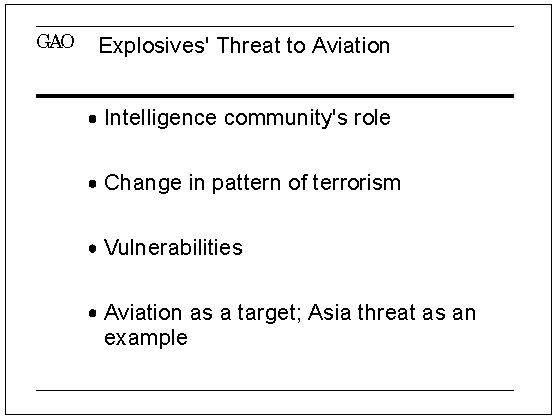
The Federal Aviation Administration (FAA) evaluates information
collected and analyzed by the intelligence community to establish
levels of terrorist threat and to determine appropriate
countermeasures. Based on classified communications that the FAA
received, it issued directives beginning in August 1995 to raise
temporarily the level of domestic aviation security.
Unclassified reporting indicates changes in the pattern of terrorism.
The terrorism threat within the United States is increasing. In
1994, the State Department reported that attacks by state-sponsored,
secular terrorist groups declined, but attacks increased from radical
fundamentalist groups, who operate more autonomously. The Federal
Bureau of Investigation reported in 1994 that the most important
development in international terrorism in the United States was the
emergence of international radical terrorist groups with an
infrastructure that can support terrorist activities. These groups
are more difficult to infiltrate, and, consequently, it is also more
difficult to predict and interdict their attacks.
Since 1991, the FAA has completed three studies to prioritize the
specific methods that terrorists might adopt to attack aviation and
to identify countermeasures. Although the studies are classified,
the unclassified conclusion has been consistent: the greatest threat
is explosives in all types of concealment. The FAA believes the
greatest vulnerability is concealment of explosives in checked
baggage. About 450 million passengers board domestic flights each
year, and the volume of their checked bags is enormous. On domestic
flights, controls over checked luggage are not as stringent as on
international flights. The FAA is funding the development of
technology to screen checked bags, passengers, carry-on luggage,
cargo, and mail.
A recent threat in Asia indicates the potential extent of terrorists'
motivation and capabilities. Information was accidentally uncovered
in early January 1995 about plans for multiple attacks on specific
U.S. flights in Asia. Existing extraordinary security procedures in
place at international airports would not have countered the specific
threat; consequently, the FAA further mandated additional security
measures at specific locations overseas. Officials told us that they
rarely have the advantage of a detailed, verifiable plot to target
U.S. airlines and that the terrorists were aware both of airport
vulnerabilities and how existing security measures could be defeated.
Security was returned to December 1994 levels in most locations
following the arrests of the plot leaders. The threat in Asia has
caused the FAA to increase research and development funding for
certain types of screening.
TERRORISM COUNTERTHREAT
STRATEGY
---------------------------------------------------------- Chapter I:2
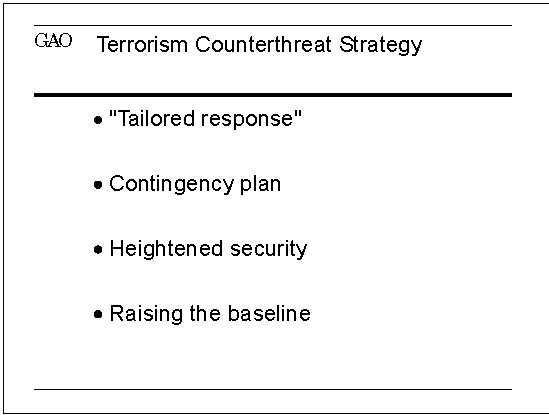
The FAA's counterthreat strategy is to mandate security measures
commensurate with, or tailored to, the level of threat at specific
places and times. The threat overseas is higher than domestically.
On all international flights, the FAA requires U.S. carriers to
implement the International Civil Aviation Organization standards as
a minimum, including the inspection of carry-on passenger baggage and
passenger bag match. Bag matching is a procedure to ensure that a
passenger who checks a bag also boards the flight; if not, the bag is
removed. The FAA also requires additional, more stringent
measures--including passenger interviews and 100 percent checked
baggage screening and supplementary carry-on baggage screening
measures--at all airports in Europe and the Middle East, and many
airports elsewhere. Further, the FAA requires, depending on the
destination, various security controls for checked bags on all
international departures by U.S. and foreign carriers from the
United States.
For flights within the United States, baseline security measures
include the use of walk-through metal detectors for passengers and
X-ray screening of carry-on luggage augmented by procedures from a
written contingency plan developed by the FAA in coordination with
the aviation industry. The plan describes a wide range of procedures
that can be invoked depending on the nature and degree of the threat.
Among these procedures are passenger bag match and passenger
profiling. Profiling is a method of identifying potentially
threatening passengers, who are then subjected to additional security
measures. Profiling reduces the number of passengers requiring
additional security measures.
For domestic flights, the heightened security measures currently in
effect are at their highest level since the Gulf War. They have
included surveillance of airport operations, parking restrictions,
and stricter control over baggage.
Senior FAA officials believe that some security measures that are now
invoked only in higher threat conditions should be incorporated into
the everyday baseline security for domestic flights. However, these
officials told us the costs and impacts of these measures would be
significant; for example, the FAA estimates that incorporating bag
matching in everyday security measures could cost up to $2 billion.
They said that standard cost-benefit analyses would likely reject
these measures, and consequently, they believe a consensus is needed
among industry, Congress, and the executive branch, before they
initiate rule-making procedures to require these measures. Further,
they believe that without consensus the rule making would fail.
PLANNED EXPLOSIVES DETECTION
TECHNOLOGY DEPLOYMENT
---------------------------------------------------------- Chapter I:3
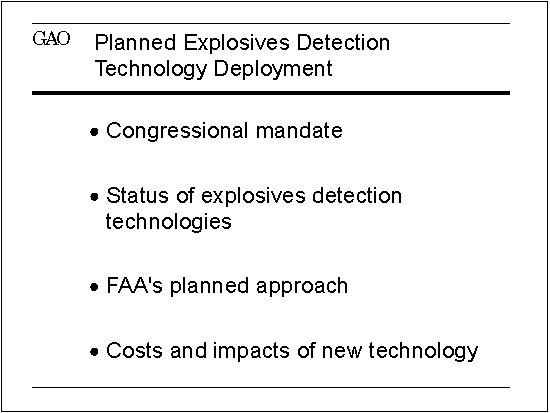
In the 1990 Aviation Security Improvement Act, Congress directed the
FAA to (1) accelerate explosives detection research and development,
which had been ongoing since 1977, and (2) certify explosive
detection systems prior to mandating their deployment. Congress
further set November 1993 as a goal for deploying new security
technology and procedures to counter terrorism. In implementing its
certification responsibilities under the act, the FAA published
criteria for explosive detection technology in September 1993 after
an extensive examination of the threat to aviation and after
coordination with other federal agencies and the scientific and
academic communities. The criteria require that a system certified
for use on checked baggage for international flights meet specific
performance requirements, using testing protocols developed by the
National Academy of Sciences, to automatically detect concealed
explosives. The FAA believes that congressional direction to develop
performance requirements and testing protocols in conjunction with
the scientific community contributed to delaying the introduction of
new technology.
Conventional X-ray devices, currently used domestically for
international flights, have performance limitations and are dependent
on a human operator's ability to interpret images for potential
threats. These X-rays performed poorly in a special assessment that
the FAA conducted in May 1994, with five U.S. carriers at four major
domestic airports that were origination points for international
flights. This assessment used moderately sophisticated, simulated
explosive devices.
Subsequent to its special domestic assessment, the FAA certified one
automated explosives detection system. The FAA does not plan to
mandate the use of this system until two or more competing systems
have been certified and airport demonstrations have been successfully
completed. Once that happens, the FAA plans a phased-in deployment
because of manufacturers' constraints on large-scale production and
the difficulty of integrating explosives detection equipment and
procedures into existing baggage handling systems. The FAA expects
to mandate the deployment of certified explosives detection systems
beginning no earlier than 1997. Some countries, such as the United
Kingdom, Israel, and Belgium, are already deploying new advanced
automated technologies.
The cost to acquire new technology is uncertain but could be
substantial. The FAA is developing a model to estimate the
systemwide costs of a variety of checked baggage screening methods,
including deployment of certified technology at the busiest domestic
airports. Preliminary FAA estimates are that one-time acquisition
and installation costs of the certified system for the 75 busiest
airports could range from $400 million to $2.2 billion, with
continuing annual operating costs of 10 percent or less. We have not
verified these estimates, which will be further refined through joint
efforts between the FAA and the aviation industry. Final costs will
depend upon several factors, including the extent to which passenger
profiling is used. According to FAA officials, profiling reduces the
number of bags screened by about 80 percent.
DRUG TRAFFICKING AND NARCOTICS
DETECTION TECHNOLOGY
=========================================================== Chapter II
NARCOTICS THREAT
--------------------------------------------------------- Chapter II:1
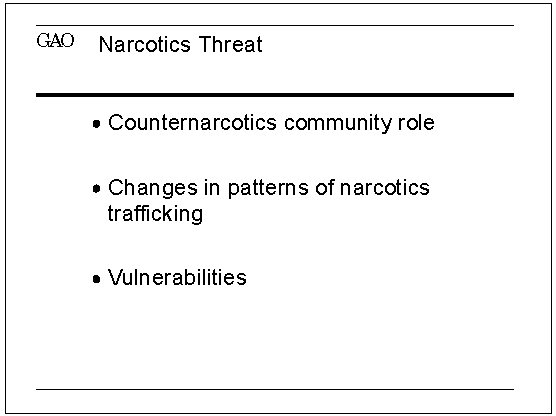
Customs relies on intelligence collected and analyzed by the
counternarcotics community as well as that gathered by its field
agents, inspectors, and analysts from investigations and seizures to
establish a general level of threat and to develop profiles for
targeting suspected threats.
The intelligence community believes cocaine has been the primary
narcotics threat since about 1985; however, heroin is becoming more
of a threat. Most of the heroin entering the United States comes
from Southeast Asia, Colombia, and Mexico. Crack-cocaine users are
increasingly using heroin to soften the impact of the "crash" that
often follows a crack-cocaine binge. Heroin now comes in a smokable
form that eliminates the perceived risk of AIDS from needles.\1
According to the Commissioner, U.S. Customs Service, the locations
and means of cocaine smuggling have changed over the years because
traffickers have tremendous flexibility. Miami and south Florida had
been the primary locations and aircraft and maritime vessels the
means, until the government's interdiction efforts caused an increase
in trafficking at the Southwest border of the United States and use
of trucks, tractor-trailers, containers and private vehicles.
Intelligence agencies estimate that 70 percent of cocaine coming into
this country enters via the Mexican border. This region is currently
the primary focus of Customs narcotics strategy.
The job of interdicting narcotics at the Southwest border is
enormous. The United States and Mexico share almost 2,000 miles of
border. Customs operates 38 ports of entry on that border through
which daily pass an average of about 240,000 trucks, cars, and other
vehicles, and 640,000 pedestrians. The North American Free Trade
Agreement is expected to increase the flow of trade between the
United States and Mexico, thus increasing the workload for Customs
along the Southwest border.
Customs and the Drug Enforcement Administration (DEA) view
containerized commercial cargo transported by trucks and ships as
posing a serious or substantial threat. Cargo inspection
technologies are particularly important because of the millions of
containers that enter the United States through hundreds of land and
sea ports of entry. Customs currently inspects less than 5 percent
of these containers. Currently, four people could be required for up
to 8 hours to unload, search, and reload a single 40-foot container.
--------------------
\1 For additional information on the heroin threat, see our report,
Drug Control: U. S. Heroin Program Encounters Many Obstacles in
Southeast Asia (GAO/NSIAD-96-83, Mar. 1, 1996).
NARCOTICS COUNTERTHREAT
RESPONSE
--------------------------------------------------------- Chapter II:2
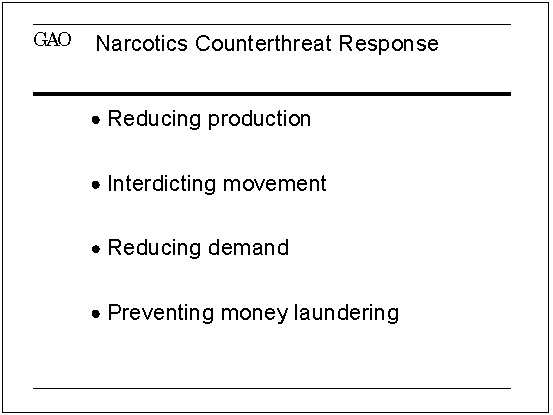
The U.S. response to the narcotics threat has generally focused on
the cycle of drug trafficking from reducing the production of drugs,
to disrupting their movement, to reducing demand, and to preventing
money laundering. Until 1993, the government emphasized
interdiction, but now the emphasis is more on production, demand
reduction, and money laundering.
The emphasis on reduced production efforts include initiatives to
eradicate crops in the source countries, dismantle cocaine cartels,
interdict drug movements, and provide such things as intelligence and
technical support to major source nations and transit countries. On
November 3, 1993, the President signed a decision directive that
announced a planned shift of emphasis from interdiction to the source
countries. Within interdiction, the directive emphasized more
selective and flexible interdiction programs in the transit zone and
near the U.S. border.
The interdiction efforts include disrupting air routes within source
countries and between transit countries, hardening the ports of entry
in the Southwest, increasing use of technology by Customs, and
building fences by the U.S. Border Patrol.
Demand reduction efforts include both drug treatment and prevention.
Treatment efforts attempt to reduce the number of chronic, hardcore
drug users by focusing on improving the effectiveness of drug
treatment provided in communities, jails, and prisons. Prevention
efforts attempt to reduce demand by keeping new users from entering
the pipeline to chronic, hardcore drug use. These efforts include
such things as advertising campaigns to deglamorize drugs and various
community and school-based programs.
Finally, the government has significantly stepped up its efforts to
prevent the narcotics traffickers from laundering their profits.
Money laundering involves disguising the funds derived from narcotics
sales and other crimes so that they can be used without detection of
the illegal activity that produced them. In October 1995, the
President announced that the executive branch would consider imposing
sanctions against nations that assist with money laundering to
prevent them from doing business in the United States.
CUSTOMS COUNTERTHREAT FRAMEWORK
--------------------------------------------------------- Chapter II:3
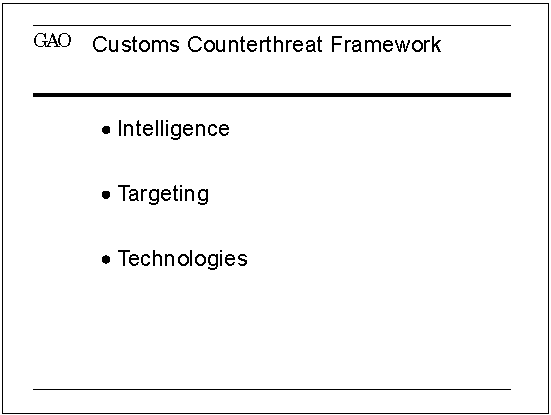
Customs' counterthreat framework along the Southwest border includes
(1) disseminating intelligence on narcotics trafficking, (2)
targeting commercial and private conveyances, and (3) using narcotics
detection technologies.
Customs is receiving intelligence from such sources as the Department
of Defense (DOD) and DEA on how drugs are smuggled into the United
States from Mexico. Customs will also place interdisciplinary teams
at field locations to enhance the collection, exploitation, and
dissemination of intelligence within the Customs intelligence system.
Since Customs cannot examine all shipments arriving in the United
States, it targets high-risk shipments for examination. Customs has
had experience with automated targeting systems and is now developing
a prototype advanced targeting model to operate on a national basis.
The model is being developed with Customs' own funding and a limited
amount of funding from the Office of National Drug Control Policy
(ONDCP).
Since 1991, DOD has spent over $240 million to develop nonintrusive
cargo inspection systems and counterdrug technologies for Customs,
DEA, and other federal agencies. Recently, DOD funding provided
Customs with an advanced, low energy X-ray system at Otay Mesa,
California, to do nonintrusive inspection of empty cargo containers
and trucks. Since 1975, Customs has developed and procured many
smaller technology devices, including mobile X-ray vans for
inspecting break-bulk cargo and hand-held range finders for detecting
false walls in containers.
PLANNED TECHNOLOGY DEPLOYMENT
FOR COUNTERNARCOTICS
--------------------------------------------------------- Chapter II:4
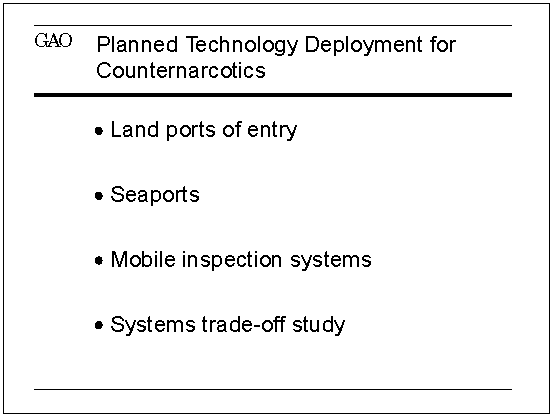
In June 1995, Customs provided several members of Congress with a
long-term plan for procuring detection technologies that includes
placing 12 fixed-site, truck X-ray systems costing about $38 million
along the Southwest border. Customs has one truck X-ray system
operating at Otay Mesa, California, and is using fiscal year 1995 and
fiscal year 1996 funds to acquire four more. The remaining seven
systems may be procured in fiscal years 1997 and 1998. The
conference report to the Fiscal Year 1996 National Defense
Authorization Act (P.L. 104-106) urged the Secretary of Defense,
through normal reprogramming procedures, to use up to $25 million of
the funds for law enforcement agency support, to procure the X-ray
systems. DOD is presently considering its options to use $10 to $15
million for the purchase of these X-ray systems.
In addition, Customs determined that there were 13 high-threat
seaports at which some cargo container inspection technology is
needed. However, Customs currently has not identified a suitable
container inspection technology for seaports.
DOD is developing mobile inspection systems for Customs. Initially,
these systems were intended for the Southwest border. Since Customs
will now deploy fixed-site, low-energy X-ray systems there, a senior
Customs official stated that the agency has to find new applications
for these mobile systems. He believes possible applications are at
airports where cargo and baggage containers could be inspected by
these systems, or at northern ports of entry.
A contractor is conducting a congressionally mandated study for
ONDCP, estimated to be completed in May 1996, on cost and benefit
tradeoffs over life cycles of various narcotics detection
technologies. Preliminary results indicate that the highest priority
should be given to funding development of intelligent targeting
software to identify high-risk shipments for examination. Additional
results indicate (1) low-energy X-rays, such as those being proposed
by Customs for the Southwest border, may be useful for empty trucks
and possibly pallet-sized cargo; (2) some ports of entry may need
high-energy X-ray systems like the one that had been tested at the
now abandoned Tacoma, Washington, facility or the ones deployed in
France, China, and Germany; and (3) nonintrusive inspection systems
may have some benefits for trade compliance. We intend to evaluate
the completed study as part of the second phase of our review, which
will deal specifically with technology development and both domestic
and overseas deployment.
MAJOR CONTRIBUTORS TO THIS REPORT
=========================================================== Appendix I
NATIONAL SECURITY AND
INTERNATIONAL AFFAIRS DIVISION,
WASHINGTON, D.C.
David E. Cooper
Ernest A. Doring
Charles D. Groves
John K. Harper
John P.K. Ting
RESOURCES, COMMUNITY, AND ECONOMIC
DEVELOPMENT DIVISION, WASHINGTON,
D.C.
Gerald L. Dillingham
Matthew E. Hampton
Thomas F. Noone
Marnie S. Shaul
*** End of document. ***







